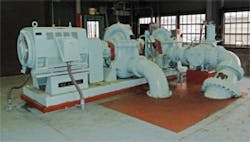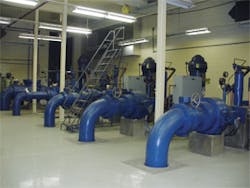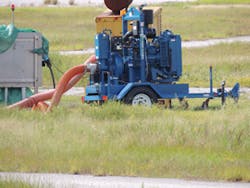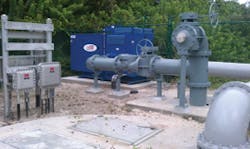In a conversation with one of my local public works supervisors it was depressing to hear how he could see the only way to improve service in a cost-effective manner was to raise the costs for users. When I asked him about the efficiency and cost-effectiveness of the water supply operations, he responded in the tried-and-true manner of one who knows that nothing could ever have been done better for the last 25 years or so. In fact, he seemed to feel insulted that I suggested there might be simpler ways to save money and improve efficiency. Were my questions negative? I don’t think so. I believe the gentleman was sure he had never done anything wrong and he despised anybody who thought he had.
He was missing the point. I didn’t think he or his colleagues were to blame. I think it has been the overall attitude to pumps that energy that is to blame. I used to be involved closely in the pumping sector of our industry, and I can remember clearly that the only possible problems for buyers and sellers were: Can this pump move enough water? Can it do it at the necessary head? End of be-concerned-about specifications. The only way that energy entered the picture was the advice that you’ll need a motor or engine of such-and-such horsepower to guarantee the pump’s performance. We must be fair and remember that the cost of power was seldom considered a factor in any projects, but, today, reducing that cost could be most significant in saving taxpayers’ money and bringing better efficiency, too.
Temporary Pumping
Let me divert your thinking just a little. As infrastructure ages and breaks down all over North America, some of the pumping we will have to do will be caused by breakages, worn out lines, and disrupted connections. The pumping needed to correct those faults is not permanent–it tends to be a temporary, rescue operation. Often, it involves a rental response. Not all pumps are electric, but energy use (especially for temporary repairs) can involve diesel and gas engines, too.
The high cost of all energy today forces us to believe it is a significant, painful aspect of all pumps. I was delighted to receive, from Thompson Pump, clearly presented and explained pages that address economy for their pumps. Thompson Pump offers engine-driven pumps and claims efficiency and low fuel consumption. Saving a gallon an hour for diesel must be an attractive proposition, so always check the power requirements of all pumps you need, temporary or permanent.
A good example of temporary pumping occurred in Oklahoma. There was a break in the water line, and it was located 15 feet below ground. Among those directly affected by the sudden loss of water were hundreds of residences, several businesses, a hospital, two universities, and five nursing homes. Many local people, including the Red Cross and Salvation Army, helped their thirsty neighbors. The director of public works says it was probably age more than anything that caused the break; that’s a situation that is going to occur with increasing frequency nationwide. To allow workers to access and mend the break, a 6-inch pump from Thompson was used.
As our water infrastructure fails, utilities must consider the efficiency and cost of temporary pumping. Repairs, whether they are in the street or more open space, will be expensive. It is doubtful that the costs for repair of our water infrastructure will come from the petty cash.
Managing to Save Energy and Money
Another misconception I’ve noticed, in several sectors of industry, such as water distribution, construction, road-building, and energy use in buildings, is that “It’s easy for those big companies, they can do what they like because they have bottomless pits of money.” The assumption is that the smaller, average company (or utility) just cannot hope to be as efficient as those bigger guys. “Bullhunkey,” as my friend from Iowa used to say about some of the sporting nonsense with which I would bend his ear. Small businesses can be as efficient as big businesses if they determine to be so and use good business practices to achieve measurable results.
One of the biggest water utilities anywhere is American Water, serving more than 15 million people in 30 states (and Canada) with efficient water and wastewater. It is also a utility that proclaims publicly how it intends to save energy consumption, bringing it down several percentage points with this decade.
How can American Water and your utility save expensive energy in the next few years, starting this year? Start with the pumps. Pumps are almost certainly the biggest users of energy in any water utility, because they are the means of moving water from its sources to its final commercial and residential destinations. Pumps are essential tools for any water utility. They are not particularly exciting tools but they have certainly done excellent work for years. Unless your water is high on the hill and your community is down in the valley, you’re going to need pumps to move the water you need to the places you want.
A phrase used by American Water in its proposals for a better, more committed and efficient company is “Energy Usage Index” (EUI). I am indebted to the company for its commitment to public efficiency by letting me quote some of its hard-earned research. EUI is a unit of measure that can be used as a benchmark to evaluate how energy efficient a water utility operation is, not just a big utility but your size, too.
The EUI is derived by dividing the annual power consumption in megawatt-hours (MWh) for a service area by the volume of water sold in a year in millions of gallons (MG). Your results can be expressed in either MWh/MG or kilowatt-hours per thousand gallons (KWh/T-gal), which are equivalent units of measure without any additional conversions. It should be noted that the power consumption used in the EUI includes all metered electrical power consumption such as: offices, operations centers, treatment, facilities, well, sites, tank sites, and booster stations.
Some factors that may affect the EUI are:
- Pump efficiency
- Efficiency of other electrical equipment
- Water system topography
- Energy-intensive treatment processes (e.g., Ozone, UV)
- Non-Revenue Water (NRW) volume
Local conditions determine the efficiency of a water distribution system; the topography can have a significant impact on your efforts. The discharge pressure from a treatment plant and the elevation of lift from your water source (such as reservoir, river, or well) to the high service pumps or distribution system can have a strong influence.
Imagine two water systems (A and B) in which the average system delivery (say 10 mgd) is the same and the pump efficiency is the same (75%), but there are significantly different head (pressure) requirements. System A’s source is a river where the elevation is only a few feet below the plant elevation. The topography of System A is quite flat, with the plant discharge pressure accordingly low at around 65 psi.
System B is in a hilly or mountainous area. The water treatment plant is at the top of a hill, several hundred feet above the raw water source. Elevations in such a water system can vary, with some customers even at elevations up to 250 feet higher than the treatment plant. This means that the plant discharge pressure is 150 psi, to give adequate pressure to all customers. These (natural) results can affect the Energy Usage Index.
Both systems A and B work well, but A’s EUI is 1.25 and B’s EUI is 3.74. Your local topographical conditions, then, can affect your theoretical efficiency. You, your employees, and your customers should be aware of this.
This relay pump’s management can be as straightforward as pumps with any function in a system.
Pumping, the Greediest User of Energy
The vast majority (about 95%) of a water utility’s electrical demand is used for pumping. Improvements in pumping efficiency will have a most significant effect on the utility’s electrical consumption.
Firstly, American Water performed pump efficiency testing at its largest facilities, and this was done by testing the “wire to wire” efficiency, which measures the combined efficiency of the pump and motor system. Based on results of the testing so far completed, American Water found an average estimated wire-to-wire pump efficiency of 60%; your utility’s efficiency could be in the same range. Replacing or refurbishing inefficient pumps could improve pump efficiencies to the 80% level.
Eliminating throttled valves and replacing old-style variable speed drives could help. At some treatment facilities and pumping stations, changing head and flow conditions can make conditions too high for the distribution system and, to compensate for the changes, the valves downstream are sometimes throttled back to reduce the discharge head to an acceptable level. That may help the operational perspective but it wastes energy, and modifications can be made to eliminate the source of wasted energy. You could install variable frequency drives (VFDs), trim pump impellers, or replace the pumps with correctly sized units. Some old-style variable speed drives, like eddy current drives, can be most inefficient, and replacing them with electronic VFDs could improve the efficiency.
It is estimated that two-thirds of pumps use up to 60% too much energy. (“This pump needs a 50-hp motor, better get 100 hp, don’t you think?”) When
Control of the pumps can be much more efficient today.
you think of the number of pumps used in the world, can you imagine how much energy would be saved if everything was done right? How much money, too?
World pump leader Grundfos makes the point that if the world switched its pumping habits to energy-efficient pumps the savings would be as much electricity as one billion people use in a year. Pumps today account for some 10% of the world’s electricity consumption and too many of those pumps are inefficient and waste the energy.
In the Netherlands, drinking water company Vitens serves almost 400,000 residents. Rob Kuipers is the Senior Technical Support Specialist at Vitens, and he questioned the energy efficiency at the company’s Harderbroek water collection facility.
“I always had this feeling that the existing pumps guzzled too much energy but I had no proof,” asserts Kuipers.
After a pump audit by Grundfos, hard facts proved Kuiper’s suspicions to be correct. By replacing their eight filtrate pumps, Vitens could save 165,000 euros over the next 15 years. The return on investment was 10 months. There is a 41% reduction in the energy consumption of the pumps, which represents a savings of 4 KWh per pump per hour (23,652 kWh in total per pump per year). The longer-lasting Grundfos pumps are running at 42 Hz, and the pump and motor efficiency has increased from 44% to 71.5%.
Grundfos thinks it has found the solution to one of the most common (and expensive) problems in pumping. The problem is that many pumps operate at a constant full speed even though it is only required for 5% of their operating time. Grundfos Blueflux pumps aim to end that wastage with high efficiency motors and variable frequency drives.
Grundfo’s VFDs are built specifically for the pumps to which they are attached, and, when combined with a sensor, they provide precise and consistent levels of control.
Finding the Right Pumps
There are many brands of pumps available in the North American market. Some of those you may have thought of as coming from separate manufacturers are now under larger umbrellas.
A backup system for a lift station in Panama City. Its good fuel consumption is an important feature.
A group that comes to mind is Crane Pump & Systems. This group includes Barnes, Deming, Prosser, Weinman, Burks, and Crown. Of those brands, Weinman and Burks may be best known for their usefulness and reliability for municipal water supply. For these applications they are end-suction pumps, heavy duty, centrifugal pumps with heavy wall castings. With cast iron cases and impellers of bronze they have the reputation for being easy-to-maintain, reliable, and long-lasting. They handle heads to 680 feet, and up to 4,000 gallons per minute.
It was a Barnes pump that solved a clogging problem in Inkster, MI. The existing pumps tended to clog every couple of days. In some cases, they clogged within minutes of reinstallation. Barnes offered a 60-day trial with one of their units (an SH Series pump). After three months serving the lift station, the Barnes pump never clogged, so the city purchased three for a permanent solution.
Mechanical seal failures are expensive problems and, on many pumps, they will fail without warning. The Village of Bradford, OH, had been suffering random failures with some of their discharge pumps, due to mechanical seal failures. To solve this expensive problem (reckoned to be about $3,000 per pump and possibly weeks of downtime) Crane Pumps & Systems suggested a Barnes pump, which took slightly more horsepower but also had a MiniCAS Replacement Relay. This device provides warning of impending seal issues with alarm connections to Bradford’s SCADA system.
So, in this case, a little more power was needed but it did solve the problem very well, for years. Pumps are well-established products (they’ve been
going for centuries!), but don’t underestimate the likelihood that today’s new electronic technologies can help you monitor and run those pumps from a remote location.
Another group whose pumps you’ll recognize–and you probably have some in your fleet of pumps–is Xylem, a name with which you may be unfamiliar. Among the Xylem brands are Bell & Gossett, FloJet, Flygt, Godwin, Goulds, Leopold, Lowara, Marlow, Red Jacket, Rule, and Wedeco. A Flygt pump used in the Town of Turnbull, Connecticut, can show how the right pump can save significant energy (and money) each year.
Engineers looked at the problem performance at one of its lift stations and decided to add a smaller, 10-hp pump with direct online motor starters and a level control system with float switches. The new pump handles the same volume as the original pumps (much more motor) during non-peak periods, but runs for longer periods of time to get the job done efficiently. The old pumps handled infrequent peak flows. The two compressors for the bubbler level control system and the two circulating pumps for the old motor control system were eliminated. The result was that energy consumption went down by also 44%. Thanks to that energy savings and to related savings in maintenance and labor, new pump sites are going to use the same techniques.
If you visit the factories of pump manufacturers you will see that their engineers and production workers are constantly trying to find ways to improve the performance and energy efficiency of their products, so it is really worthwhile doing some homework, telling your potential suppliers the real nature of your pumping challenges, and determining who is going to solve your problems in the best, and most economical, long-lasting way.
It is not always the electric motor which causes the unnecessary use of electric power. It could be the pump itself. Water utilities may have pumps that are 50 years old. They have done good service, required little maintenance, but they are almost certainly less efficient than when they first started to work for you. A pump is, basically, a mechanical piece of equipment. Parts wear out. Parts can be rehabilitated to bring the pump back to near its initial efficiency. Impellers can be inspected and, quite quickly, given treatment that will repair their weakening over the years.
Advice I have seen or heard more than once is: “If you feel you must replace an old pump, rather than repair it, then seriously consider replacing its electric motor, too.” The compared costs of rehabilitation and replacement are always worth careful study.
Improving pump performance is not the only way to save electricity at the water utility, but it can be a powerful step in the right direction. The reasons for wasted energy are not always related to pump performance. Some waste has been caused by inaccurate forecasts made several years ago of the amount of water needed in a community. Some municipalities have expected strong increases in population, and that may not have happened.
Consider that water supplies were planned for the increased residential population and for the businesses that were going to serve them. This situation is a good opportunity for a water utility to determine how it can best serve the real market rather than the imagined one. It can mean work on the pumps, but it can also mean investigation of ways to ensure that water is available when it is needed but not using energy when it is not needed.
Yes, it is a complicated scenario. Blaming somebody is probably the worst approach. If economic circumstances have changed your needs, that’s a much broader challenge than just pump performance.
Those who have been in the municipal field of water distribution know that the money available for improvements usually comes about two years after the general economy improves. At the time of writing, there are signs of an improving economy, so major purchases may have to wait a couple of years yet, but all the solutions for reducing energy in the pump operations do not have to involve buying new pumps. There’s some research and investigation needed first.






